Thresh Guide: How To Play Thresh And Reap Your Opponents’ Souls
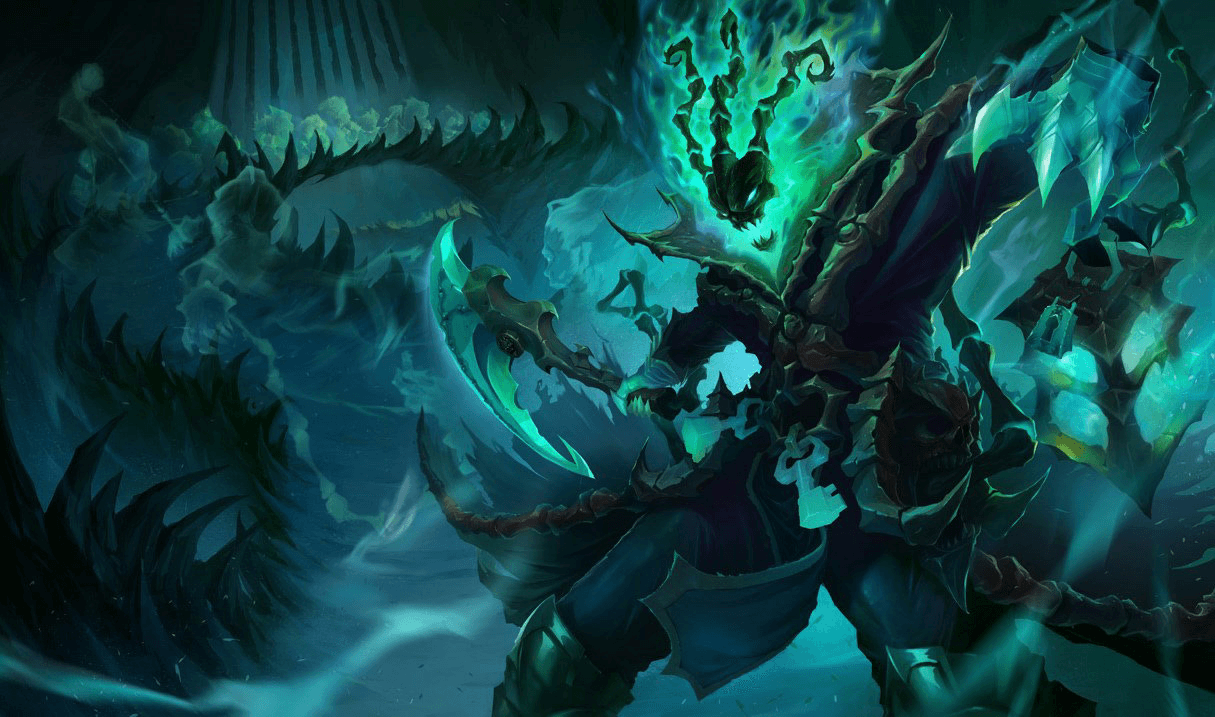
Ever since his release in 2013, Thresh has been the most popular or second most popular support. A playmaker with an arsenal of tools at his disposal, with depth and skill expression, with pro players even leaving their name on plays for this champion, it’s easy to understand how he earned that spot. But with great potential comes a great learning curve (that’s the quote, right?), so this guide is here to teach you how to play Thresh and harness the power of his kit.
Let’s kick off this Thresh guide with a recap of his abilities.
Thresh's Abilities Explained

Thresh’s Passive Skill - Domination
Enemy champions, enemy minions, and monsters that die near Thresh have a chance to drop a Soul for 8 seconds. Thresh collects the souls by walking near them or having a Dark Passage on them. Thresh permanently gains 0.75 armor and 0.75 ability power for every soul he collects.
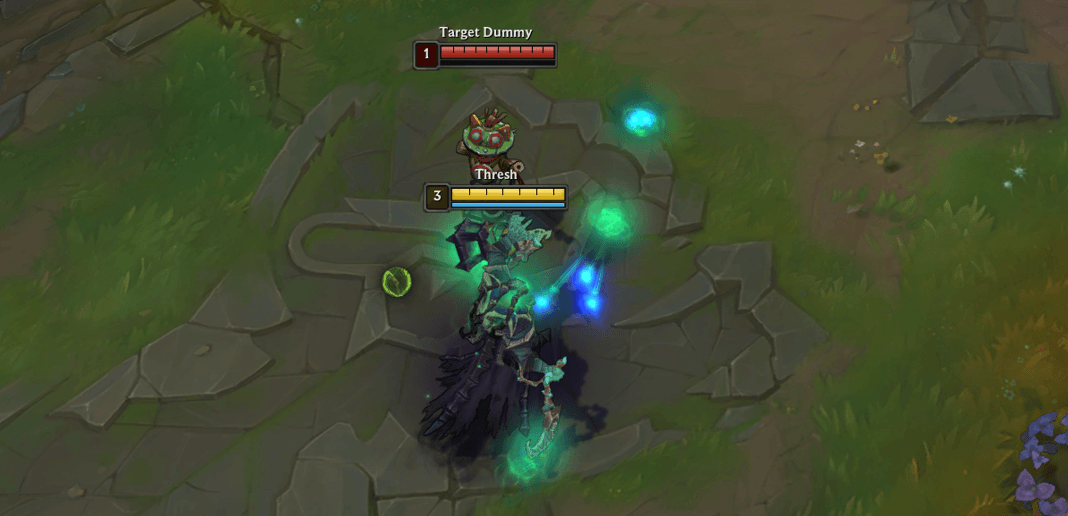
Enemy champions, enemy minions, and monsters that die near Thresh have a chance to drop a Soul for 8 seconds. Thresh collects the souls by walking near them or having a Dark Passage on them. Thresh permanently gains 0.75 armor and 0.75 ability power for every soul he collects.
How to Use Damnation
Damnation makes the difference that you won’t see. As the price to pay for this passive, Thresh is the only champion who doesn’t gain armor per level. That makes him need those souls to survive while also giving him the possibility of passively having stronger stats than any other champion’s.
All small minions and monsters have a 1/3 chance of dropping a soul upon dying, while champions and large minions and monsters are guaranteed giving one. This means that each wave gives 2 to 3 souls, as will most jungle camps - if Thresh is around when they are killed.
This means that in order to be strong, Thresh needs to find his balance between staying around waves and camps for souls, and being efficient in his time when moving around the map. Stay for a few seconds to help manage a minion wave, take a small detour to collect the three souls from that camp, but don’t stay glued to a lane or to the jungler instead of applying pressure and setting vision. Thresh players need to make sure they have great map awareness to go where they are needed most.
Additionally, Thresh’s Lantern is a good tool to use to harvest a few souls that’d be over a wall (namely, in the jungle), but it’s also a key ability with a long cooldown. Make sure that you won’t risk needing it in the next 20 seconds before throwing it for souls, and if you aren’t sure, don’t take the gamble.

Q: Death Sentence
Active: Thresh throws out his scythe in the target direction. If it hits an enemy, they are dealt magic damage, stunned for 1.5 seconds, and progressively hooked towards Thresh. While reeling in, Thresh is unable to attack and is slowed by 20%, and he can recast the ability while the target is hooked to instantly dash towards them and stop tugging.
Death Sentence’s cooldown is reduced by 3 seconds if it hits a target.
Note: Thresh is able to use abilities during his Q, and to use his other non-ultimate abilities while dashing.
Damage: 80/120/160/200/240 (+50% AP) - Magic
Cost: 70 mana
Cooldown: 20/18/16/14/12
How to use Death Sentence
Death Sentence is Thresh’s defining ability. It’s the first thing players think of about this champion, because a hook will always be the game-winning or game-losing part of a kit. As such, this is the ability to put the most attention on when learning how to play Thresh.
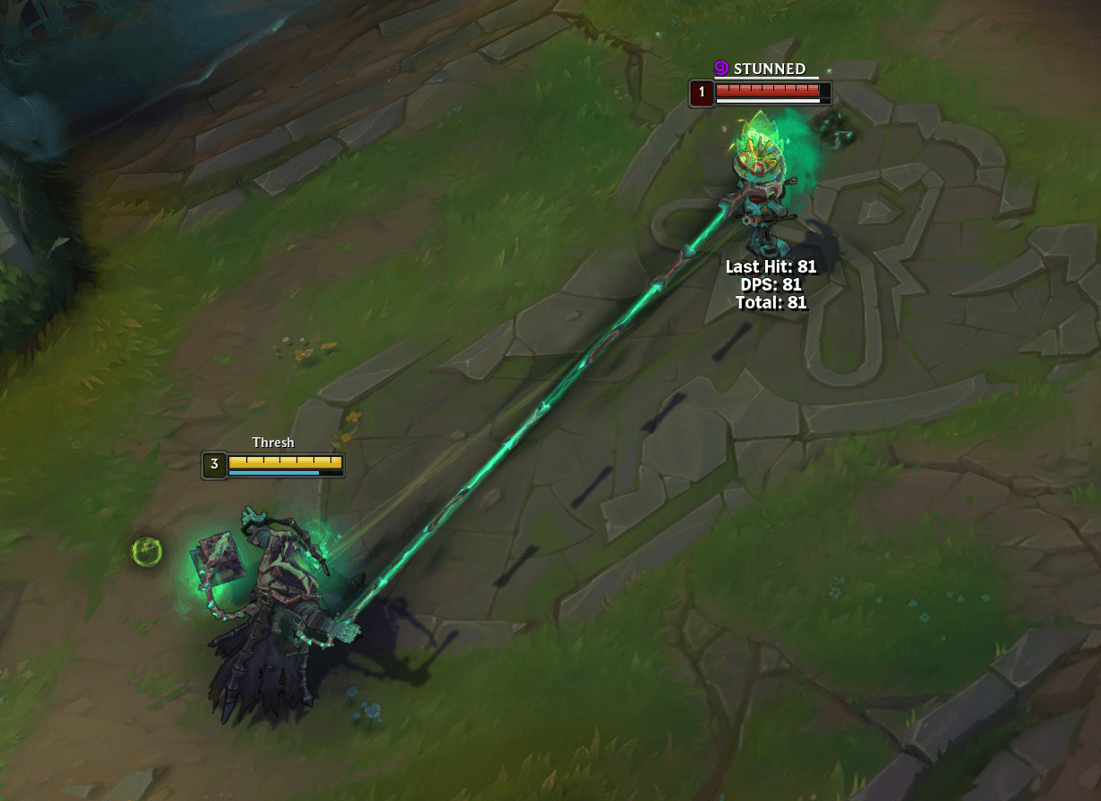
Death Sentence is Thresh’s defining ability. It’s the first thing players think of about this champion, because a hook will always be the game-winning or game-losing part of a kit. As such, this is the ability to put the most attention on when learning how to play Thresh.
However, as this makes up the core of Thresh’s gameplay, it will have its separate section, under “How to catch opponents with Thresh’s Death Sentence”.

W: Dark Passage
Active: Thresh throws his lantern to the target location. It lasts for 6 seconds or until Thresh moves too far away from it, giving him sight of its surroundings.
Going near the lantern gives Thresh and up to one allied champion a shield for 4 seconds. An ally can click on the lantern while in proximity of it to dash to Thresh. Doing so removes the lantern, and champions affected by an ailment preventing the cast of a dash aren’t able to select the lantern.
Shield strength: 60/90/120/150/180 (+1 per Soul collected)
Cost: 50/55/60/65/70 mana
Cooldown: 22/20.5/19/17.5/16
How to Use Dark Passage
It’s surprising that a champion with a hook also possesses one of the most game-warping abilities in the entirety of League of Legends, but that’s what’s made Thresh always be relevant!
Thresh’s lantern gives mobility to champions that don’t have any, most notably giving a good escape to immobile marksmen. It bails allies out of bad situations, allows for more aggressive plays thanks to the way out it brings, and gives follow-up to Thresh’s engage abilities. And on top of this, it also works as a baiting tool, gives a shield, and provides vision!
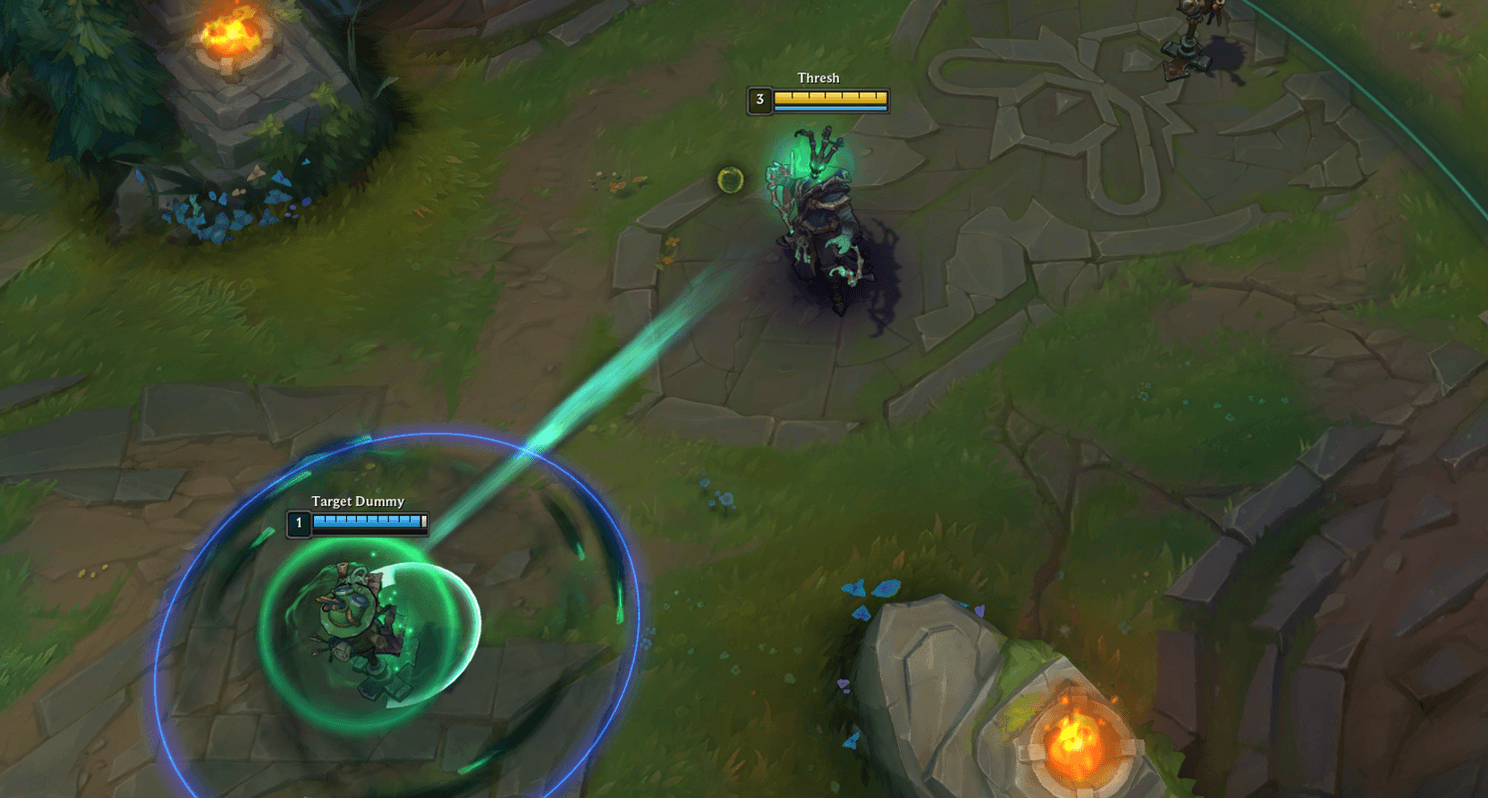
Thresh’s lantern gives mobility to champions that don’t have any, most notably giving a good escape to immobile marksmen. It bails allies out of bad situations, allows for more aggressive plays thanks to the way out it brings, and gives follow-up to Thresh’s engage abilities. And on top of this, it also works as a baiting tool, gives a shield, and provides vision!
The simplest use of Dark Passage is for engages. Send your jungler a lantern when they approach the lane to make them instantly cross the gap, or throw your lantern back after landing a hook on an opponent, allowing one ally to dash onto them alongside you.
The other side of the coin is less straightforward to handle optimally. Dark Passage is an escape… but that requires Thresh to not be in the middle of the action. As a result, Thresh needs to posture slightly behind and out of danger when he wants to provide protection for his priority teammates. But that means trading against his ability to be threatening as well as his ability to provide close-range defensive CC. Thus, learning how to play Thresh includes detecting when his role is to play up, and when he should be in the backlines instead.
When there is no need for mobility, that’s when Thresh can afford to make use of the other aspects of his W, such as throwing it in for a shield or to collect souls.
And lastly, the vision part is not to forget, especially for a support. Still while the ability won’t be needed for anything else, Thresh should use his lantern to avoid face-checking a bush that he wants to ward, or a dark area.
Advanced trick: When Thresh uses his lantern to bring his jungler in, the jungler may initially be out of sight for the enemy team. This can be used to his advantage - Thresh can throw a lantern back without the jungler being there, to initiate a trade feigning the presence of backup, deterring the enemies from fighting back as they focus on running instead.
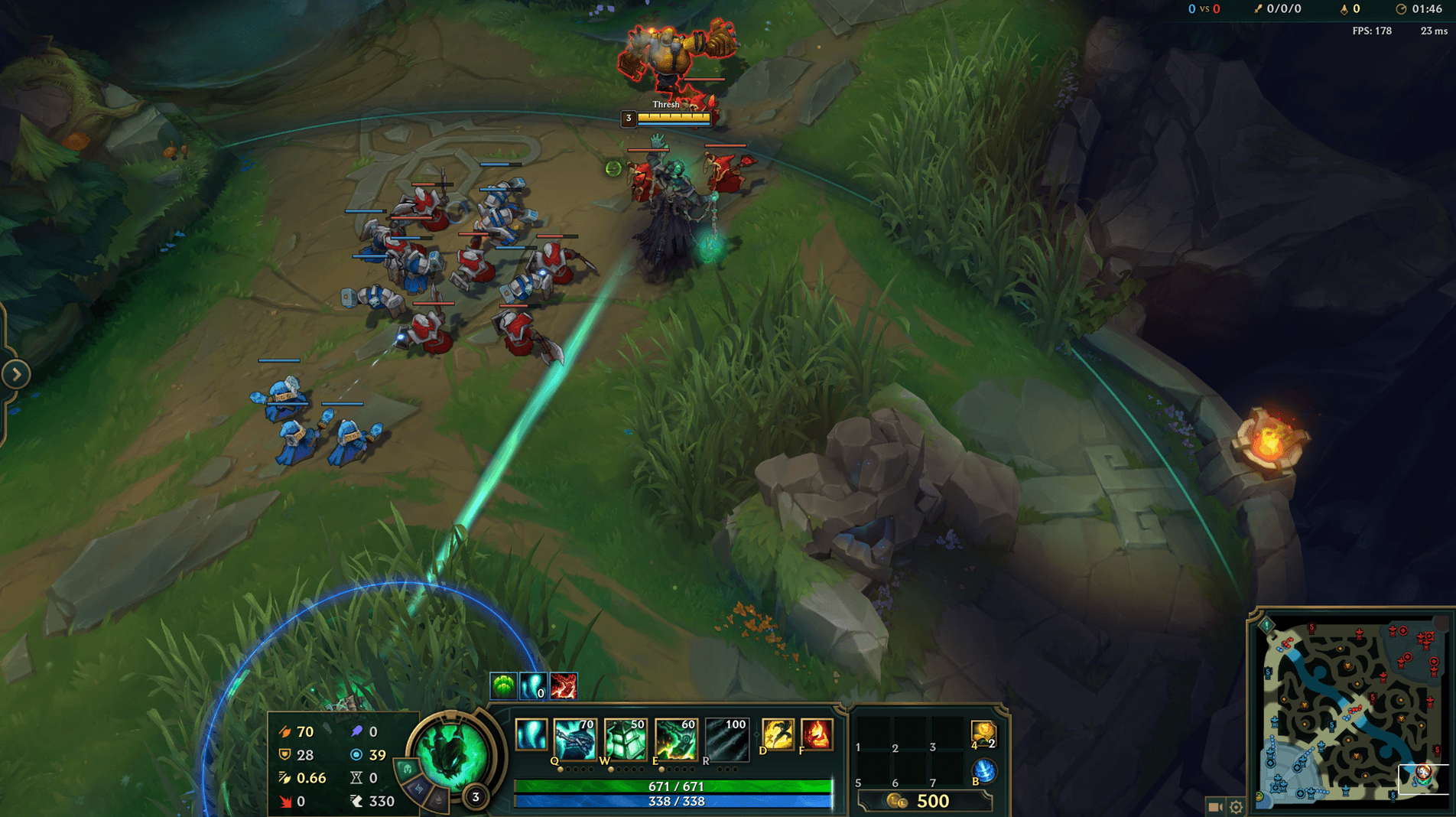

E: Flay
Passive: Thresh’s basic attacks deal bonus damage based on the Souls he collects. Additionally, his basic attacks charge while he’s not attacking, making his next strike deal bonus damage based on the duration of the charge (up to 10 seconds).
Active: Thresh sweeps his chain across the ground in a broad line, starting behind him and towards the target direction. Enemies struck by the chain are dealt magic damage, knocked 200 units towards the chain’s direction, and are slowed for 1 second upon landing.
Passive damage (Souls): 1.5 per Soul collected - Magic
Passive damage (Charge): Up to 80/110/140/170/200% AD - Magic
Active damage: 65/95/125/155/185 (+40% AP) - Magic
Slow: 20/25/30/35/40%
Cost: 60/65/70/75/80 mana
Cooldown: 13/12.25/11.5/10.75/10
How to use Flay
Compared to the rest, Flay is a simple ability to use - albeit not easy either. Flay can be used as:

Compared to the rest, Flay is a simple ability to use - albeit not easy either. Flay can be used as:
- A tool to keep the opponents immobilized after the hook,
- A sure way to engage and to set up for the hook,
- A peeling and disengage tool,
- A spell of lower cooldown to use in fights whenever it comes back up.
Flay goes in the direction of the cursor, sending the opponents forward or backwards. However, be sure to practice aiming it, as it’s easy to not get the direction correctly initially, especially when aiming close to Thresh himself.
Note: Being a knockback, Flay cancels all dashes that it connects with. Keep the spell available when facing a champion whose engage is a dash, such as Leona, Zac, or Leblanc, and it’ll make life extremely hard for them.

Thresh Ultimate (R): The Box
Active: Thresh surrounds his location with a pentagon of spectral walls that last for 5 seconds. Walls break upon contact with an enemy champion. The first champion hit takes magic damage and is slowed by 99% for 2 seconds, while further champions passing through walls are only slowed for 1 second.
Damage: 250/400/550 (+100% AP) - Magic
Cost: 100 mana
Cooldown: 140/120/100
How to use The Box
Well, this spell is even simpler this time! The Box is an AoE crowd control spell that almost fully prevents opponents from walking, but lets them use mobility spells (or spells or attacks in general).
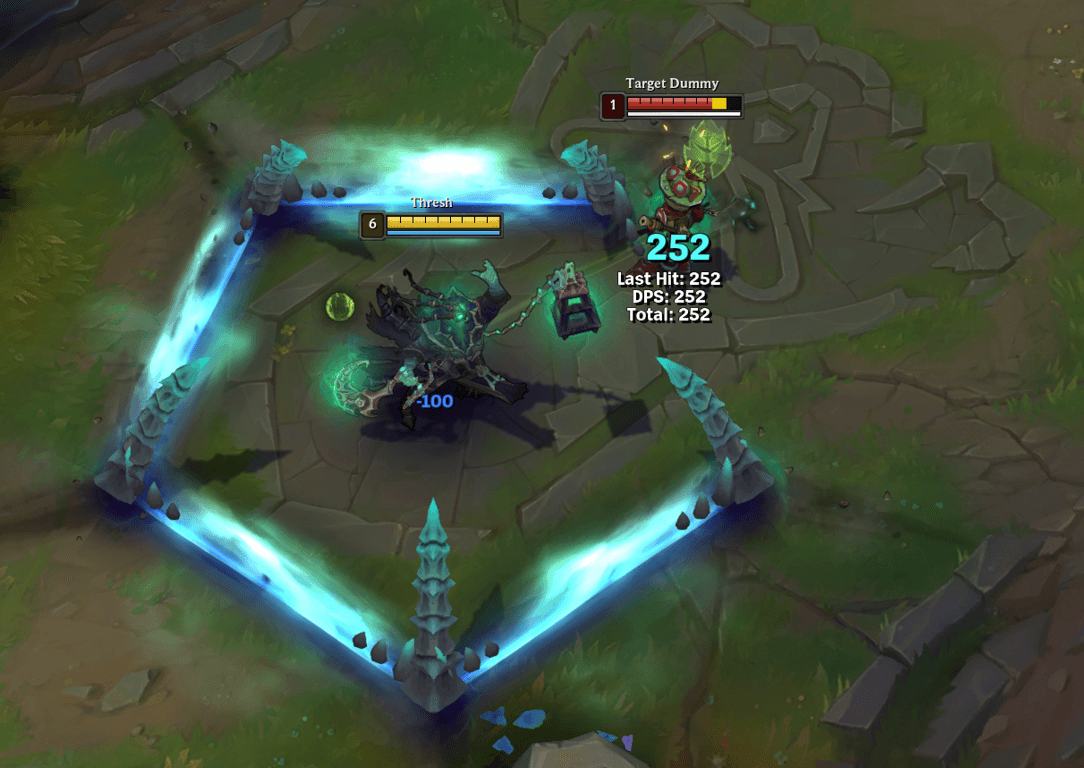
Well, this spell is even simpler this time! The Box is an AoE crowd control spell that almost fully prevents opponents from walking, but lets them use mobility spells (or spells or attacks in general).
Use Thresh’s ultimate after a hook as a third means of locking down the opponent, or when opponents chase you down to block their way! Note, however: the ability has a short but noticeable cast time, during which Thresh is immobile and the walls aren’t active yet. Don’t use it when the chased opponent is at the edge of the range, or when you’re almost in range for a chasing one to land a fatal ability.
How to Catch Opponents with Thresh’s Death Sentence
Death Sentence is the first aspect in this Thresh Guide to bring up as part of how to play Thresh. Everything can work thanks to successful hooks, everything can fail because of missed hooks, and the concepts of how to play each stage of the game will revolve around the knowledge of how to catch people.
Naturally, a big part of learning to aim the spell is practice and habit, getting used to the range, width, and speed. But there are tricks that can be spelled out and learned.
1) Learning the dodge patterns of diagonal hooks.
Diagonal hooks are the hooks thrown when Thresh is positioned laterally compared to the direction he and his target are running back towards.
The first level of thought is for Thresh to aim his hook where his target will be in half a second, and for the target, to not be where they would normally be had they followed their normal pathing. This is normally done by taking a step backwards as Thresh casts his hook. So the question for Thresh becomes whether the opponent will try dodging, or continue walking.
If Thresh expects his opponent not to dodge, he simply hooks forward. If he expects them to dodge, he has to hook where they currently are instead. However, the issue is that the spell will only connect if the prediction was correct.
But the odds of landing the Death Sentence can be increased by understanding players’ trends.
- In the lower League of Legends ranks and up until gold, the players are most likely to not try to dodge in lane.
- The higher the elo, the more likely the opponents are to walk backwards, and predicting a dodge ends up being the correct choice more often than not.
- The laning phase is where the players are the more alert, and as such, the more apt to dodge. That makes dodge prediction less efficient outside of the lane.
- In tense situations, players lose their habits. Opponents are less likely to attempt to dodge if there is a lot going on or if they don’t expect the hook.
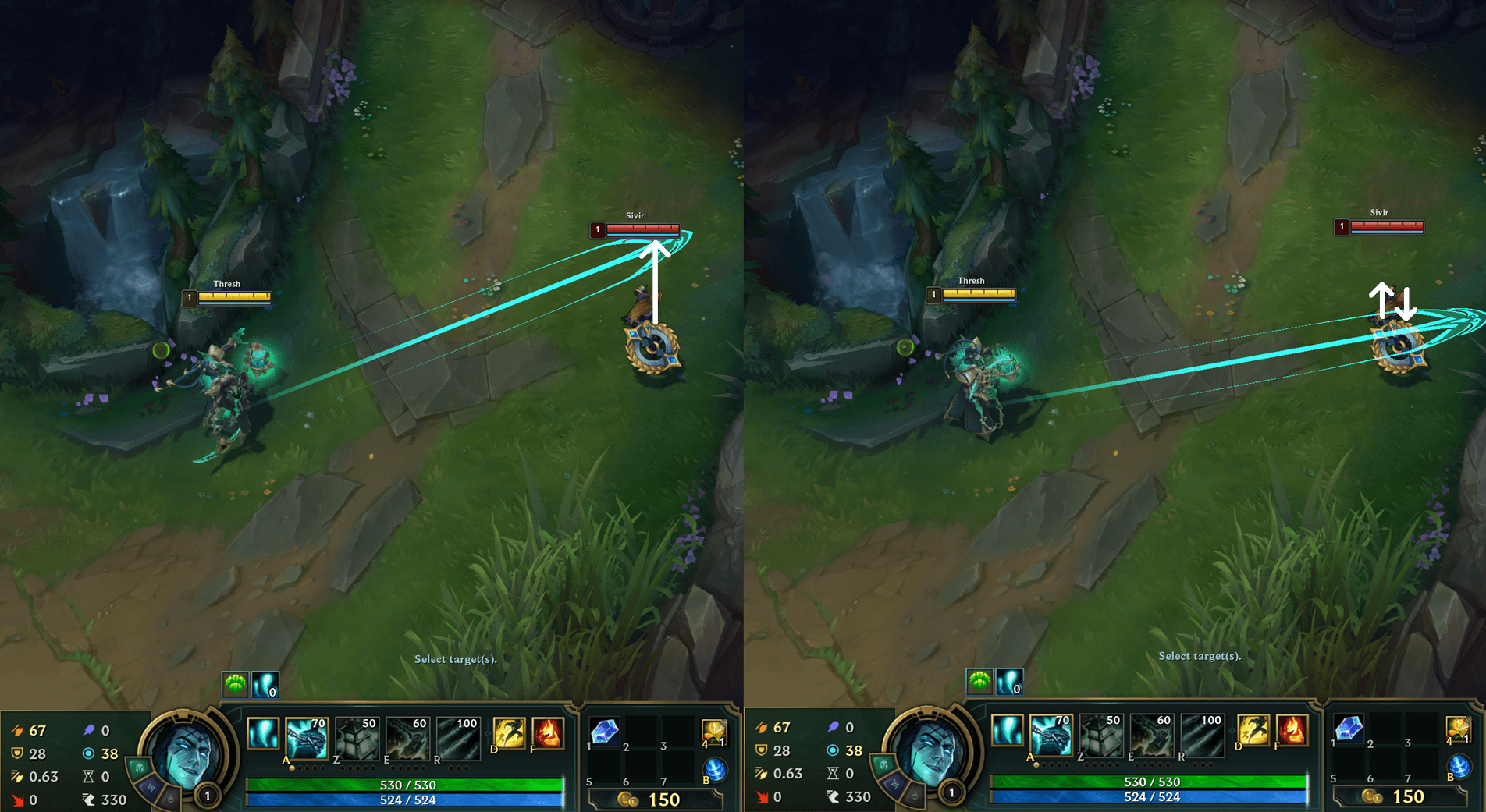
2) Going for straight hooks instead of diagonal hooks.
For the above reason, diagonal hooks sometimes amount to a coinflip where the opponent has good chances of dodging. However, straight hooks don’t give this opportunity. Straight hooks are when Thresh, his target, and the direction they’re running into, all form a single line.
In these situations, the Death Sentence aims at both the target and the position they’ll be at by the time the hook reaches, which makes it much more complicated to dodge. Mobility spells aside, the only way to evade a straight hook is by moving aside exactly as Thresh winds up for the ability. It has to be done predictively rather than reactively, making it a gamble with much lower chances of success for the opponent.
Of course, all of this depends on the position of both players, and Thresh doesn’t always have the luxury of orienting himself for a straight hook. But if the enemy turret or the danger zones are far enough, Thresh may want to walk up diagonally instead of hooking right away, in order to reduce the distance, and then throw a straight hook.
This is made even more effective if you have the possibility to corner them against a wall, meaning that there is even only one direction they can dodge into.
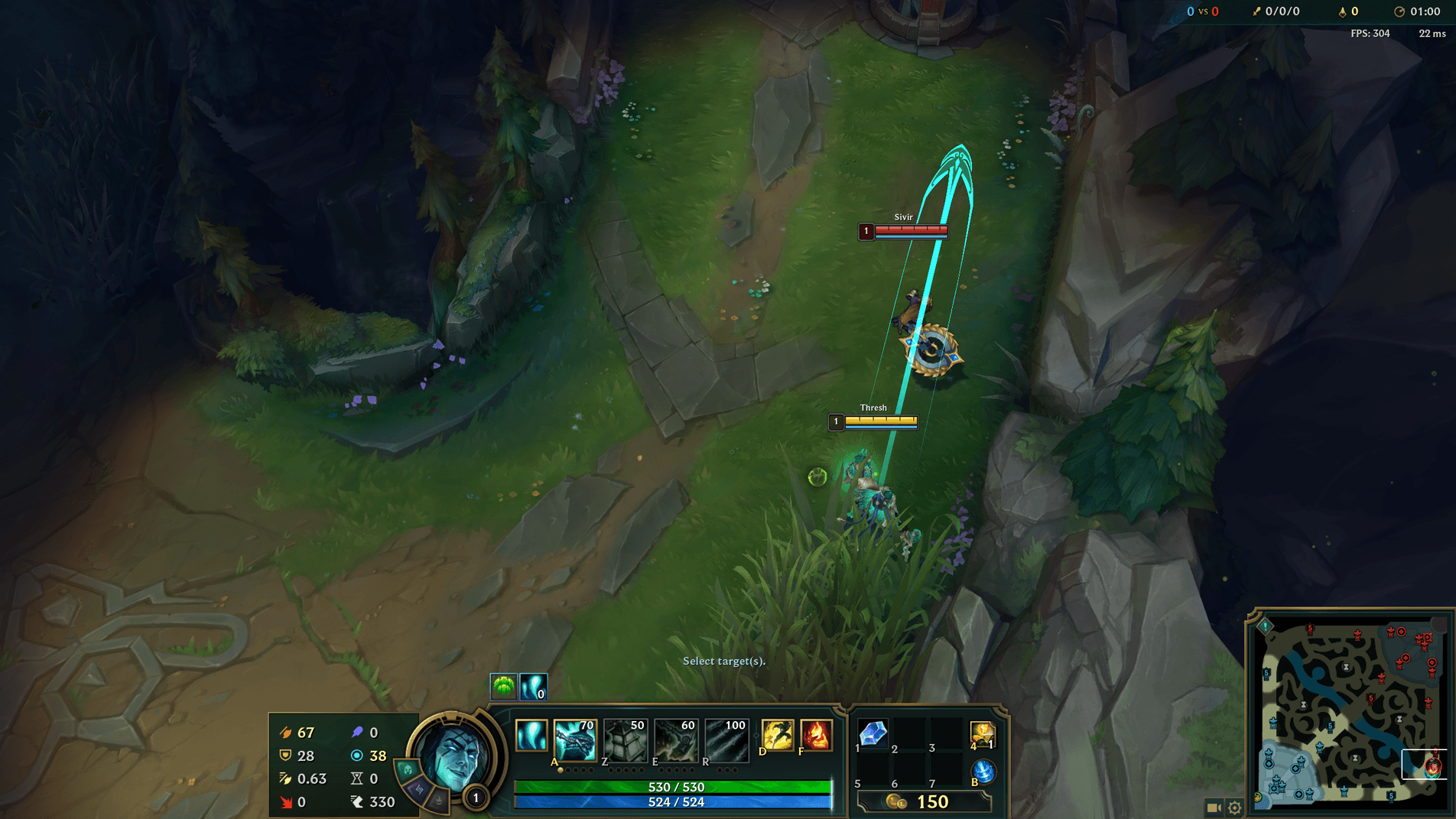
3) Walking instead of hooking.
The way to dodge straight hooks is by predicting the timing of Thresh’s hook. In order to do so, the target has to walk erratically to the side while running away, losing a lot of ground in the process. Doing so works in order to dodge the Death Sentence, but puts the opponent in a bad spot if Thresh simply decides not to hook and to walk up instead.
By just walking to the opponent, Thresh will catch up to them, and he can then be in range to use his other abilities. Those virtually can’t miss and will slow the target enough to ensure that the hook will hit as well.
4) Not using Death Sentence.
Strangely, one of the major points of learning how to play Thresh is learning to not use his Q. Hook champions pretty much consist of “one hook and filler abilities”. Thresh’s other abilities are useful, but most of the power budget is put into his Death Sentence. So while this ability is on cooldown - which lasts for 20 seconds initially - the Chain Warden is only half a champion.
Most importantly, while the hook is on cooldown, Thresh’s pressure is gone. So if you’d want to randomly fire a hook but think that it’s unlikely to hit, don’t. This game isn’t about missing all the shots you don’t take, but rather paying for all the shots you do take, and so they need to be worth the price.
5) Thinking for your opponents.
In the end, most of how to play Thresh and of the tips above can be grouped under “understand how your opponents are currently thinking”. The advice that’s applicable everywhere else on League applies here too: _think_. Think and don’t autopilot. Think about what your opponent is thinking, to understand how they might react (Dodging? Running? Flashing?), and pick the option that answers what they’re expected to do.
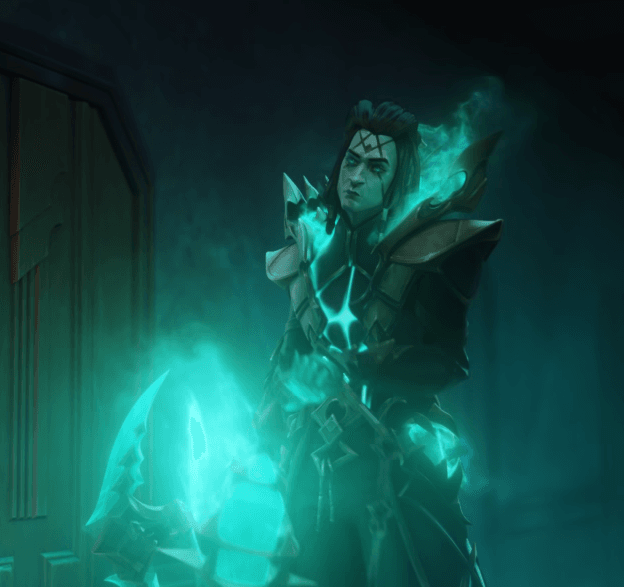
In the end, most of how to play Thresh and of the tips above can be grouped under “understand how your opponents are currently thinking”. The advice that’s applicable everywhere else on League applies here too: _think_. Think and don’t autopilot. Think about what your opponent is thinking, to understand how they might react (Dodging? Running? Flashing?), and pick the option that answers what they’re expected to do.
All the tips above are the most common examples of this “think and act accordingly”, but this is the general rule that they originate from.
6) Understanding the difference between good plays and fancy plays.
The appeal of Thresh is making plays. Landing those crazy hooks one after the other, reading the opponent’s mind, flashing to get a Madlife prediction, being the warden that guards the door to victory from the enemy team.
That’s not the way to win.
Crazy plays can be good and they have their place somewhere. But they’re a supportive part of the game plan rather than the game plan being making plays. No matter how good it feels, a predictive flash-hook is useless if there is no possible follow-up and if the hook can’t be converted into a kill or other form of advantage.
Of all the supports, Thresh is most likely to get this drive of making plays. And that’s why it’s particularly important to keep in mind that said plays are additional means to reach the goals and not goals themselves. Thresh needs to stick to his support game plan in the first place, and to make plays when they contribute to the plan.
How to play Thresh in Lane
In lane, Thresh receives a hybrid role. He most resembles initiating supports, but his kit also has poke patterns. His initiation abilities don’t force him to commit, and he’s a ranged champion with added damage on his basic attacks. However, marksmen and real ranged support largely beat his own range, and he doesn’t get enhanced durability like all other initiators and wardens do, as a trade-off for his range.
This makes Thresh wind up with options to pick from based on the match-up and on the state of the lane.
- Against melee supports and short-ranged opponents, Thresh can use his hook and flay to harmlessly keep them in range for a few attacks, and passively pokes with his own basic attacks. He can repeat the process until they’re low enough to commit for the finishing blows. In return, he can fend off engages and won’t die in one spell rotation, but still needs to not expose himself too much.
- Against higher-range enemies - who are more brittle - Thresh’s spells become killing tools, and he’ll use his hook and flay to put himself in range, in order to negate the opponents’ advantage and go for all-in trades right away.
After gaining an advantage, the Chain Warden can start walking up in lane to exert pressure, denying resources to the opponents or threatening them with hooks. Everything else about how to play Thresh in lane comes down to execution: knowing his strengths and weaknesses, all that’s left is playing into the strengths, using the catching techniques, and transforming them into advantages.
How to play Thresh All Over the Map
As a support, Thresh’s role throughout the game is to be the driving force of ward placement, ward sweeping, vision control and to create favorable situations all around the map. To roam through the map to gank in 2v1s or to turn a 2v3 into a 3v3.
This is the textbook support role. Thresh’s specific contribution to it manifests in having excellent offensive and defensive potential, through his hooks, his lantern, and his unavoidable short-range crowd control.
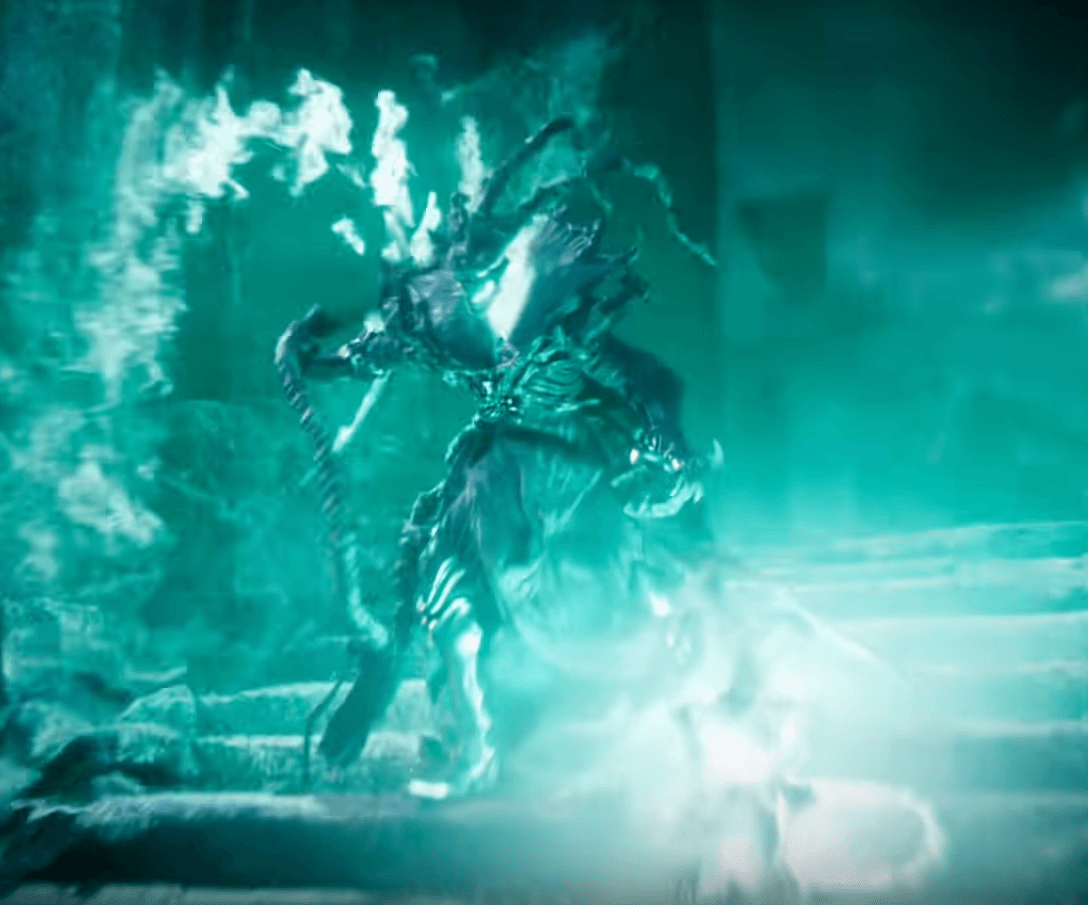
This is the textbook support role. Thresh’s specific contribution to it manifests in having excellent offensive and defensive potential, through his hooks, his lantern, and his unavoidable short-range crowd control.
However, the two downsides to this are that less mixed champions fill these individual roles better (a Leona’s Solar Flare works better than hooks, and Lulu’s protection usually grants more defenses than Dark Passage), and that Thresh has a heavy execution burden on his shoulders. Most of Thresh’s interventions rely on him executing properly with many occasions to misplay.
And so it’s in the Chain Warden’s case in particular that you need to learn how to play Thresh’s micro in order to allow the macro to be successful. On the other hand, said micro has to be put to the service of the macro in order to be of any use.
Thresh guide - Final Thoughts
Thresh is the most popular support for a reason, being “the playmaker”. He also has some great Thresh skins to really make playing him quite fun! On the other hand, the ability to win a game through outplays comes alongside the ability to lose it through misplays, making it crucial to learn how to play Thresh for any person who wants to pick him up.
However, the reward to harnessing the Chain Warden is having a Swiss knife in your pocket - a support that has the tools to do anything.
To continue from here, here is a great Thresh build guide to be sure to put all the odds in your favor!
Images Courtesy of Riot Games.
